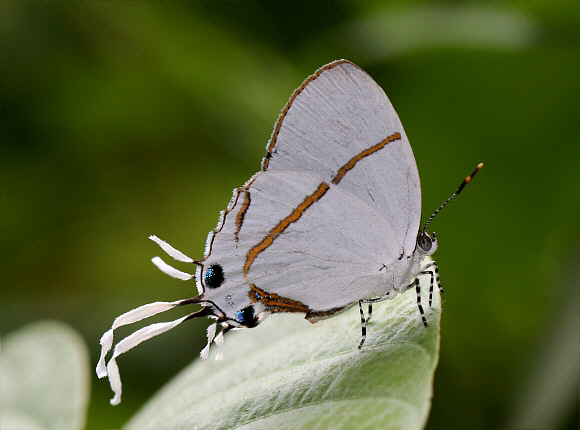
Introduction
The subfamily Theclinae comprises of almost 3000 species worldwide, 520 of which occur in the Afrotropical region. On the upperside the males of most species have metallic blue scales, while the females tend usually to be earthy brown in colour. The forewings generally have a pointed apex, and the hindwings have a tornal lobe, which in many genera is extended to form a thin tail. On the underside there is usually a black cubital spot at the base of the lobe, often crowned with orange.
There are 7 known Oxylides species, all confined to the Afrotropical region. In common with Iolaus, Etesiolaus and Hypolycaena the undersides are white, with an orange ‘hairstreak’ line running from the costa of the forewing to the tornus of the hindwing. All 4 genera have long filamentous tails, and a dark cubital ocellus, creating the impression of a false head, complete with ‘antennae’, which are often wiggled when the butterfly is at rest.
The false head has undoubtedly evolved as a survival strategy. An insectivorous birds will watch a butterfly as it settles, and then immediately attack. It will invariably aim its beak slightly ahead of the butterfly so that it can be captured even if it starts to fly. When an Oxylides lands on a leaf or flower it immediately rotates on its axis to face the opposite direction, and starts wiggling its tails to draw attention to the false head. Under these circumstances the bird is fooled into aiming its attack at the tail, or slightly behind the butterfly, which then flies in the opposite direction and escapes unharmed, or at worst with a peck out of its hindwing.
Oxylides faunus is a West African species, found from Guinea-Bissau to Cameroon.
Habitats
This is a forest species, which tends to be found in small flowery glades and along logging roads.
Lifecycle
To be completed.
Adult behaviour
Both sexes nectar at various wild flowers, always holding their wings erect when feeding. They are reluctant to move when feeding. If deliberated molested they take to the wing slowly and flutter a short distance to settle on a nearby bush. Within a few minutes they invariably return to the exact same flower from which they were disturbed, and continue feeding. An individual butterfly will often return to the same patch of flowers on several days in succession.
